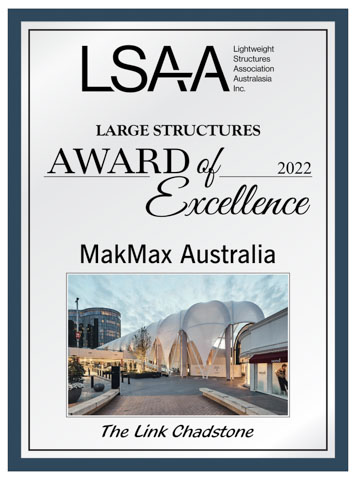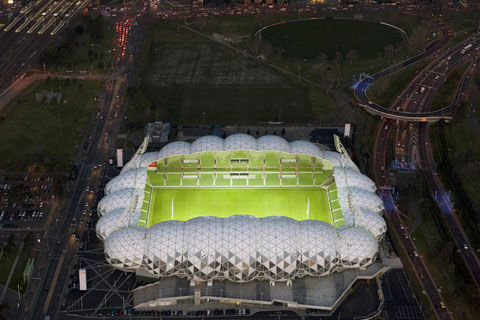
APPLICATION OF PROJECT:
The Link Chadstone is a covered walkway between Chadstone shopping Centre and Hotel Chadstone Melbourne.
PROJECT DESCRIPTION: The Link Covered Walkway
The Link walkway in Chadstone is a visually stunning fabric-over-glulam structure that provides easy covered access for patrons between the Chadstone Shopping Centre and Hotel Chadstone Melbourne.
Commissioned by leading Australian real estate investment trust Vicinity Centres, and completed in October 2019, The Link is a 100m arched walkway that soars up to 15m above the pedestrian zone and is covered with 1750m2 of high-translucency THV-coated PTFE fabric.
Designed to blur the lines between the retail, commercial and leisure zones of Chadstone’s high-end fashion shopping precinct with the newly opened Hotel Chadstone Melbourne, MGallery by Sofitel, The Link transforms part of a multi-level car park into a luxurious, cathedral-like promenade for shoppers and hotel guests.
DESIGN / FABRICATION / INSTALLATION BRIEF
The designing architect’s vision of The Link was to complement Chadstone Shopping Centre’s existing vaulted glass roof with an iconic light and airy structure created with glulam timber arches, covered with a semi-translucent tensile fabric membrane.
As the membrane contractors, the design and engineering challenge we faced on The Link was to deliver a premium tensile membrane finish to complement the projects’ luxury look and feel. With the aim to link the new 5-star Hotel Chadstone to the Chadstone Shopping Precinct – the membrane finish had to embrace the high-end, luxurious aesthetic of the project.
STRUCTURAL SYSTEMS
While large in scale and scope, the over-riding principle demanded by the client was to create a luxurious structure that would be equal parts aesthetically pleasing and impressively grand to patrons. We needed to innovate to find solutions that made sure the structure was engineeringly sound, while still meeting the architect’s aesthetic brief, and to this end, The Link walkway incorporated several unique structural systems and unusual design loadings.
One of the structural systems we paid close attention to was the location of load paths at the field joints. The multiple planes of tension and curved surfaces, coupled with corresponding offsets that generated bending movements within the Glulam arches required multiple solutions of our cable and fabric long-term load restraint systems. This made the initial sequencing of the load resistance systems complicated.
The graceful arched curves of the glulam structure required innovative thinking to maintain tension in the membrane. The scalloped membrane sections curved down the side of the structure, and along with the geometry of the timber arches, meant that our cable angles needed to be out of rotation to the membrane plates. Some careful and detailed load analysis ensured that adequate tension was maintained, while keeping the fixing details as unobtrusive as possible.
MATERIALS
The 100m walkway reaches up to 15m high and is covered with 1750m2 of high-translucency THV coated PTFE fabric. Chosen for its high-strength and pliable PTFE fibres to optimise light transmission and diffusion, the tensile fabric membrane protects customers, guests, and visitors from the weather, while still connecting them to the environment.
A strong design focus was made to the membrane detailing, ensuring all fixings were minimal and discreet, while still offering the strength and flexibility required for installation. This task was made more difficult by the multi-planar fixing surfaces each glulam leg provided and the restrictions of fixing to glulam itself. The solutions that were incorporated into the final structure look light and inconspicuous, fitting in with the language of the rest of the design.
The breathtaking visual effect that results from the high-translucency fabric and light finish of the glulam timber, provides an incredible sense of openness, while maintaining architectural continuity between the hotel and the mall. The high transverse arches create an almost cathedral-like nave that draws pedestrians along and upwards via a series of escalators into the alter of Melbourne’s Fashion Capital, Chadstone.
Stainless steel cables were used on the lowest points of the membrane, where the gracefully curved catenary edges met in our unique arrow-head membrane plate, which was then anchored 2 metres above the ground.
FABRICATION
Instead of our usual process of designing structures, where we start off with a detailed design brief from the client and then apply our value engineering to translate that design for construction and installation, on the Link project, we were fortunate to have a great deal of involvement and input with the initial design phase. This meant were able to incorporate the design work within the structural systems from the outset.
As part of the process, we made multiple prototypes of the field joints and fixing planes at our fabrication facility in Brisbane and invited the client and stakeholders to come and view and comment.
This ability to fabricate and experiment onsite during the design phase helped to shape some of the key aesthetic details.
COLLABORATION, CONSTRUCTION AND MAINTENANCE
Having limited site-access on the Link’s construction site was a challenge to overcome in the installation phase. The structure needed to be integrated into the existing (and operational) shopping centre and required construction work to be conducted directly on top of several layers of basement. Multiple forms of access and W@H equipment were employed to transport the fabric over the top of the structure and affix it to the wooden sections.
We used prototypes of the fabric on the bottom of the structure to guide where the final membrane would fit and to find the exact locations of where the connection plates and other hardware would sit on each glulam leg. Once the panels where in place and secured we then positioned the fabric sections (which were in rolls) on top on the structure and these were secured in place by struts and the panels were rolled down one at a time.
We then had to tension the fabric making sure all other parts of the panels on the structure aligned. The fabric was installed in 3 separate sections along the structure to facilitate a safe install procedure.
Ensuring the clean-lines and luxury feel of design brief was met, we planned to hide the fixing hardware, such as membrane plates, screws, and bolts, behind the glulam frame. This proved a challenge on the side of the structure closest to the shopping centre exterior wall, as there was very little space between the structure and the building. The team had to use rope access and have special drill parts and screws fabricated for the job so they could get the screws in down the sides.
The final result was well worth the effort and The Link stands as one of the finest examples of lightweight membrane architecture we’ve had the privilege to be involved with.
COSTS
Confidential
COLOUR IMAGES and Credits
- 4133_01-fixing-plate-prototype.jpg
- 4133_02-Installation-frame.jpg
- 4133_03-installation-frame2.jpg
- 4133_04-first-fabric-roll.jpg
- 4133_05-installation-membrane.jpg
- 4133_06-under-canopy-rope-access-installation.jpg
- 4133_07-membrane-plate-detail1.jpg
- 4133_08-membrane-plate-detail2.jpg
- 4133_09-FINAL-detail.jpg
- 4133_10-FINAL-interior1.jpg [photo credit Peter Bennetts]
- 4133_11-FINAL-exterior.jpg [photo credit Peter Bennetts]
- 4133_12-FINAL-interior-2.jpg [photo credit Peter Bennetts]
- 4133_13-Aerial.jpg [photo credit Peter Bennetts]
- 4133_14-FINAL-membrane-detail.jpg [photo credit Peter Bennetts]
- 4133_15-FINAL-HERO.jpg [photo credit Peter Bennetts]
OTHER INFORMATION
https://www.youtube.com/watch?v=oOImdnYG8Uw&t=3s
PROJECT CREDITS
Project ID Number 4133
Project Name The Link, Chadstone
Project Location 94 Batesford Road, Chadstone, VIC, Australia 3148GPS Location -37.884829794 145.076166362
Completion Date Oct-19
Preferred Category 4 - Large Structures
Entrant Name MakMax Australia
Address 133 Lavarack Ave, Eagle Farm, QLD, AUS 4009
Contact Phone Number 736335900
Email Address
Website Address www.makmax.com.au
Entrant Type / Role Designer / Engineer / Fabricator / Installer
Project Client Vicinty Centres
Project Architect Make Architects & Cera Stribley Architects
Structural Engineer Keagan Leamy - MakMax Australia
Fabricator(s) MakMax Australia
Others Subcontractors: Steelman Fabrication, Bespoke Wire & Rope, Skymaze






